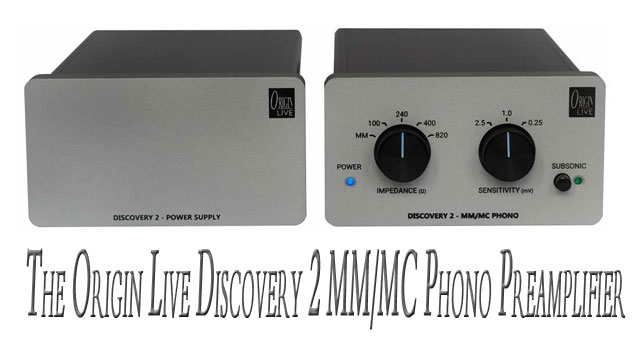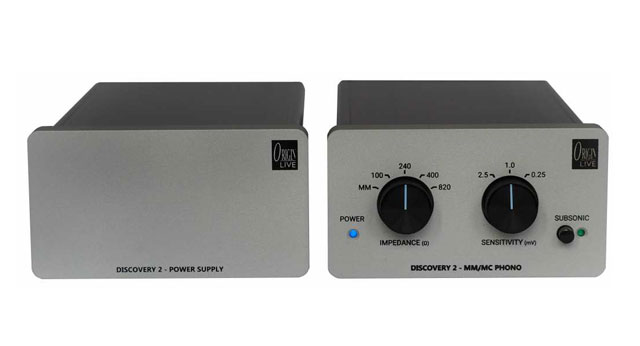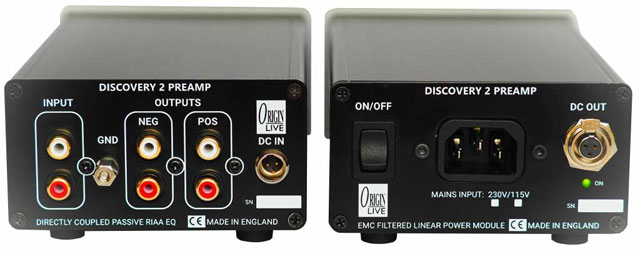Origin Live Discovery 2 MM/MC Phono Preamplifier by Paul Szabady

One of the happiest discoveries of my reviewing efforts since the turn of the Millennium has been the products of the UK firm Origin Live. Designed by founder Mark Baker, Origin Live’s extensive lines of turntables, tonearms, DC motor conversions, turntable accessories, cables, and arm modifications stand at the avant garde of Analogue LP playback performance. Firmly rooted in the long UK tradition of profoundly music-making analogue devices, Origin Live’s products mate their superb musical communication with an equally exceptional ability to capture the ultimate degrees of fidelity and resolution. My recent Origin Live product review – the Resolution MK IV turntable with the Enterprise MK3 C tonearm – had me listening to recorded music with the same profound aesthetic satisfaction that I experience when listening to music live. A very very rare achievement that. The name “Origin Live” is not an aspirational metaphor at all, but a concrete achievement.

The Discovery 2 is Origin Live’s new phono preamplifier. Consisting of 2 boxes, with one a remote power supply, the Discovery 2 allows preamplification of all types of phono cartridges, whether low-output, medium output, or high-output. Five front-panel selectable impedance choices and 3 levels of gain (46, 56, and 66 dB) are available. The front panel also sports a defeatable sub-sonic filter. Real panel connection is a bit unusual as it permits single-ended or balanced operation, the latter requiring an optional 4 RCA-to-XLR interconnect. The Discovery 2 was designed in collaboration with Simon Clark. The price is 1800 UK Pounds, or US$ 1815 (based on no VAT and the Pound/Dollar exchange rate on 7/11/2020.)
 Origin Live recommend a 40-hour burn-in period for MM input and 100 hours for moving-coil cartridges. The power switch, located on the back of the power supply activates an ‘On’ LED on the switch, and also lights up a blue LED on the front panel of the preamp. This LED will periodically wink while the unit is warming up. This winking can last up to an hour.I left the Discovery 2 continuously powered up since it consumes so little electricity. I began to get a strong hint of its potential after about 50 hours of constantly being on, but waited till 100 hours of moving coil playback before giving full credence to my perceptions.
Origin Live recommend a 40-hour burn-in period for MM input and 100 hours for moving-coil cartridges. The power switch, located on the back of the power supply activates an ‘On’ LED on the switch, and also lights up a blue LED on the front panel of the preamp. This LED will periodically wink while the unit is warming up. This winking can last up to an hour.I left the Discovery 2 continuously powered up since it consumes so little electricity. I began to get a strong hint of its potential after about 50 hours of constantly being on, but waited till 100 hours of moving coil playback before giving full credence to my perceptions.
I first inserted the Discovery 2 into my ‘rationally affordable’ living room system, which consists of my budget reference Monitor Audio Bronze 5 loudspeakers (now superceded by a very similar model in Monitor Audio’s new line-up) fed by an Origin Live Aurora MK2 turntable with Origin’s Onyx tonearm, mounted with an Audio Technica AT OC9 ML low-output MC cartridge.
The OC9 ML is now 3 generations out of date and has always been a chameleon in its performance. I’ve heard it sound steely bright and harsh, with a recessed midrange, and only so-so bass extension when played through a compromised Front-End. I’ve also heard it sound gloriously and completely wonderful when played in the Origin Live Resolution MK 4 turntable and OL Enterprise arm. So, it was a good test-mule for waiting out the Discovery 2’s burn-in period.
The first sign that the Discovery 2 is something very special soon became obvious with this difficult cartridge. The long-held perceptions of the cartridge’s weaknesses were shown to be but an indication of a limitation in partnering components. With this Origin Live front end the OC9 ML positively bloomed: midrange became full and rich with heightened harmonic content and the improvement in bass dynamics, authority, punch, and overall quality was simply intimidating. While the cartridge has the typical classic moving-coil rising top octave, the Discovery 2 was able to reproduce the high frequencies with a stunning clarity and freedom from hash and hardness, readily showing off the OC9 ML’s superb tracking ability.
Here we have a $200 (close-out street price at the end of the OC9 ML’s product run) cartridge that can worry $2,000 contemporary cartridges in performance. It was getting very clear that the Discovery 2 was something very much more than very special.
 I listened to the Discovery 2 with a variety of Front-Ends that included 4 moving-magnet cartridges: Audio Technica VM95 ML, Nagaoka MP 500, Shure V-15 V xMR, and Garrott Bros. Optim FGS; 3 moving-iron: Grado Signature TLZ-V, Origin Live Aladdin 2, and The Cartridge Man Music Master; 3 high-output moving coil: LP Gear BIN 323, Sumiko Blue Point #2, and Sumiko Blue Point Special w/ Garrott Bros. MicroTracer stylus; and 5 low-output moving-coil cartridges: Audio Technica AT OC9ML, Goldring Eroica LX, Hana SL, Sumiko Talisman Boron, and Dynavector Karat Diamond. The Discovery’s selectable gain and impedance choices made cartridge-matching a non-issue. Since auditioning this range of phono cartridges also involved use of multiple tonearms and turntables, I was able to get a reliable perception of the D2’s overall performance.
I listened to the Discovery 2 with a variety of Front-Ends that included 4 moving-magnet cartridges: Audio Technica VM95 ML, Nagaoka MP 500, Shure V-15 V xMR, and Garrott Bros. Optim FGS; 3 moving-iron: Grado Signature TLZ-V, Origin Live Aladdin 2, and The Cartridge Man Music Master; 3 high-output moving coil: LP Gear BIN 323, Sumiko Blue Point #2, and Sumiko Blue Point Special w/ Garrott Bros. MicroTracer stylus; and 5 low-output moving-coil cartridges: Audio Technica AT OC9ML, Goldring Eroica LX, Hana SL, Sumiko Talisman Boron, and Dynavector Karat Diamond. The Discovery’s selectable gain and impedance choices made cartridge-matching a non-issue. Since auditioning this range of phono cartridges also involved use of multiple tonearms and turntables, I was able to get a reliable perception of the D2’s overall performance.
After the burn-in period I did all my auditions through Sound Lab Dynastat electrostatic-dynamic hybrid speakers driven by Prima Luna preamp/power amp tube electronics, all isolated with StillPoints universal resonance isolators.
Immediate and obvious to all my auditions was the fact that the Discovery 2 is an ultra-resolution, ultra-accurate, and ultra-dynamic-range phono preamplifier that communicates the musical contents of recordings at a reference level of clarity and quality.
We know that perception of sound relies on transient response and timing. The initial transient tells where a sound is coming from, followed almost immediately in time by the frequency response and overtones that tell us what is making the sound. Music is the temporally organized production of sounds to serve an expressive and aesthetic end, and also depends on this primary perception of sound.
So, accurate reproduction of transient response – its complete envelope of initial transient, sustain, and decay – is essential to music perception. The Discovery 2 is exemplary in its speed, timing, and tracking of relative volume levels of sound, resulting in a clarity and purity of the entire transient envelope that serves all aspects of all music, irrespective of its type.
The Discovery’s clarity extended equally throughout music’s frequency range and coupled to its exceptional range of dynamic expression was able to communicate the subtlest and most nuanced musical expression as vividly as the most dramatic and melodramatic large-scale dynamic musical demands. It could handle the drive and aggressive bombast of Hard Rock as well as the subtlest lyricism of a solo violin; communicate the stoned lope of Reggae rhythm as clearly as the terraced dynamics of Baroque music; and articulate and precisely punctuate the musical conversation of Chamber Music, both Classical and Jazz.
 The Discovery 2 was extremely transparent to interconnect choice, accuracy of tonearm/cartridge set-up, record condition, and the ultimate performance capabilities of each turntable, tonearm, and phono cartridge. While it didn’t gloss over limitations, it also didn’t spotlight them, offering a true and literal account of their sonic and musical capacities. It offered a noted and exceptionally wide range of musical expressiveness – from the most subtle to the most raucous – and communicated the emotional and artistic intent of the music directly and without bowdlerization.
The Discovery 2 was extremely transparent to interconnect choice, accuracy of tonearm/cartridge set-up, record condition, and the ultimate performance capabilities of each turntable, tonearm, and phono cartridge. While it didn’t gloss over limitations, it also didn’t spotlight them, offering a true and literal account of their sonic and musical capacities. It offered a noted and exceptionally wide range of musical expressiveness – from the most subtle to the most raucous – and communicated the emotional and artistic intent of the music directly and without bowdlerization.
The Discovery 2’s recreation of instrumental sonority was equally exquisite, offering heart-meltingly and unutterably beautiful tonalities in all the choirs of the Classical orchestra, absolutely nailing the distinctions within the woodwind/brass family, string section, and percussion group. Equally, it clearly depicted the deliberate distortion and electronic effects of the most intense electric guitar pyrotechnics while still revealing the player’s touch, technique, and emotional intent.
The Discovery 2 was superb in portraying both the forest and the trees, allowing one to follow individual instruments and instrumental lines while keeping the overall movement in focus. Untangling the most complex scoring of classical orchestra lines was actually easier than live. Moreover, it could swing effortlessly from pppp to ffff without any hint of strain. The Discovery’s dynamic ease augmented its rhythmic sophistication and ability to reveal even the most complicated polyrhythms and shifts in tempo. Given excellent recordings and a front-end up to the task, the Discovery routinely cast images outside the boundaries of the speakers and of the room.
The Discovery 2 phono preamplifier continues and amplifies Origin Live’s long-standing reputation for producing analogue playback gear that is first-class in musical communication and in ultimate sonics. Thus, it serves the needs of both Musicophiles and Audiophiles in equal measure. Its flexibility allows maximum information extraction from all types of phono cartridges. The Discovery 2 strikes me as a “final destination” phono preamplifier for serious music lovers. Given its exemplary performance, it is very reasonably priced, and is, thus, deserving of the most enthusiastic of recommendations.

![]()
paul szabady
Specifications
Price: Discovery 2 Phono Stage $1812 US, £1,800 UK
Gain – 46, 56 and 66dB
Input Impedance – 100, 240, 400, 820 and 47K ohms
RIAA deviation – 20Hz – 20kHz +/- 0.5dB
Noise – 1nV per Hz squared
Power consumption – 2W
Dimensions in mm – 109 x 59 x 190 (W x H x D)
Mains supply – 230V or 110V (factory set)
Connections:
RCA phono input sockets
RCA phono output sockets (positive and negative phases)
Ground terminal
Address: Origin Live
Unit 5 362B Spring Road
Southampton
Hampshire
SO19 2PB
UK
Phone: +44 (2380) 578 877
Email: originlive@originlive.com
Website: https://www.originlive.com/
Stereo Times Masthead
Publisher/Founder
Clement Perry
Editor
Dave Thomas
Senior Editors
Frank Alles, Mike Girardi, Russell Lichter, Terry London, Moreno Mitchell, Paul Szabady, Bill Wells, Mike Wright, and Stephen Yan,
Current Contributors
David Abramson, Tim Barrall, Dave Allison, Ron Cook, Lewis Dardick, John Hoffman, Dan Secula, Don Shaulis, Greg Simmons, Eric Teh, Greg Voth, Richard Willie, Ed Van Winkle, Rob Dockery, Richard Doran, and Daveed Turek
Site Management Clement Perry
Ad Designer: Martin Perry







Be the first to comment on: Origin Live Discovery 2 MM/MC Phono Preamplifier by Paul Szabady